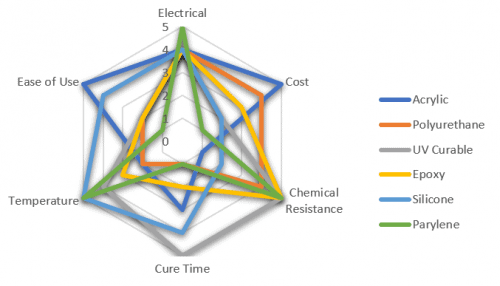
Choosing the right conformal coating depends on your material needs – namely, which certifications (IPC or UL?) are required, what environmental conditions the coating must withstand, and what your processing capabilities are. Thus, conformal coatings should not be ranked best-to-worst, but rather upon best fit.
For example, an indoor circuit board does not require the extreme protection afforded by an epoxy, just a simple acrylic conformal coating that protects against dust and electrical surges is sufficient. Conversely, a PCB mounted under the hood of a car requires the enhanced protection of epoxy or UV cure materials that can deal with fuel vapors, road salts and frequent shocks. When choosing a coating system, each conformal coating technology must be evaluated on both its strengths and shortcomings, weighed against your specific needs.
Acrylics – Acrylics are excellent materials for mild environments where the main concerns are intermittent exposure to humidity, salt spray, dust, and fungus. Its strengths are low cost, ease-of-use and rework. Its disadvantage is poor chemical resistance.
Polyurethane – Polyurethanes provide all the protection of acrylics plus some resistance to chemical solvents, excellent abrasion resistance and strong adhesion at low temperatures. Their downside is their relatively long cure time, which makes them less than ideal for high volume applications.
Silicone – Silicones are prized principally for their high temperature resistance and softness. Compared to most other conformal coating types, silicones have an exceptionally low modulus, which makes them ideal for coating delicate surface mount devices or for applications that involve harsh thermal cycling. Silicone coatings are not used when protection from oils and other solvents is required and can sometimes be cost-prohibitive when compared to other products.
Epoxy – Epoxies provide superior protection compared with acrylic, polyurethane and silicone. They protect against common contaminants like moisture, but also against harsh chemicals and abrasion, and help secure solder joints against shocks. Application can be relatively cumbersome, with a long cure time, so their use is generally limited to applications that require enhanced protection.
UV Cure – UV cure coatings boast unrivalled cure speeds. Other chemistries take hours to cure, but UV materials can be cured in seconds, which helps to ensure high throughput, making them ideal for large-volume projects. However, to realize their full benefit, substantial capital expenditure is required, including automated spray equipment, radiometers and curing lamps/conveyor systems. So before opting for UV, a thorough cost benefit analysis should be done.
Parylene – Parylene is distinct from every other conformal coating technology in that it is a powder that is applied to PCBs through a process known as chemical vapor deposition. This process is extremely cumbersome and requires highly specialized equipment. However, the cured coating offers unmatched electrical insulation, overall coverage and temperature resistance. Parylene is used exclusively when a completely homogeneous film is a must.

